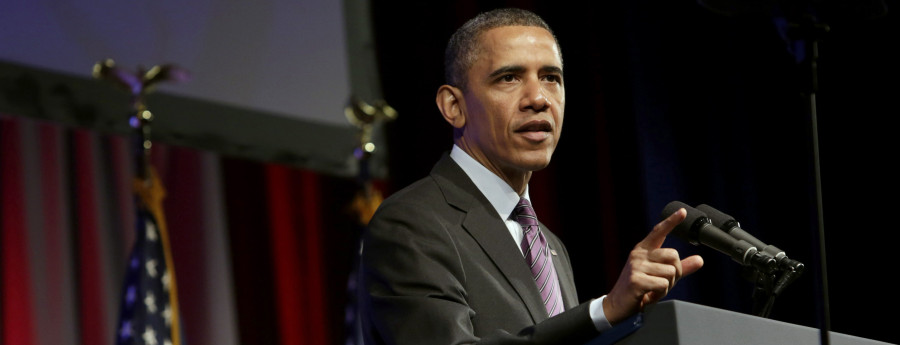
http://www.nytimes.com/2013/06/26/us/politics/obama-plan-to-cut-greenhouse-gases.html?ref=global-home&_r=0
By MARK LANDLER and JOHN M. BRODER

WASHINGTON — President Obama, declaring that “Americans across the country are already paying the price of inaction” on climate change, on Tuesday announced sweeping measures to reduce greenhouse gas pollution and prepare the nation for a future of damaging weather aggravated by rising temperatures.
Embracing an issue that could define his legacy but also ignite new battles with Republicans, Mr. Obama said he would use his executive powers to require reductions in the amount of carbon dioxide emitted by the nation’s power plants.
That was the centerpiece of a three-part plan that includes new federal spending to advance renewable energy technology, as well as spending to protect cities and states from the ravages of storms and droughts that are exacerbated by a changing climate.
Saying science had put to rest the debate over whether human activity was warming the earth, Mr. Obama said, “The question now is whether we will have the courage to act before it is too late.”
“As a president, as a father and as an American, I am here to say, we need to act,” he said to students and others gathered in a sunbaked quadrangle at Georgetown University. “I refuse to condemn your generation and future generations to a planet that is beyond saving.”
For Mr. Obama, it was a bold attempt to stake out an achievement that could define his legacy as president. But unlike with the health care overhaul, he is being forced to rely on executive authorities, since passing legislation to address climate policy would be a near impossibility in a deeply divided Congress.
He briefly addressed the pending decision on whether to allow the construction of a 1,200-mile pipeline from oil sands formations in Alberta to refineries in the Midwest and the Gulf Coast. Mr. Obama, who has been under heavy political pressure from opponents and supporters of the $7 billion project, said the pipeline should be built only if it did not have a major effect on the climate.
“Our national interest will be served only if this project does not significantly exacerbate the problem of climate change,” Mr. Obama said in a statement that cheered pipeline opponents. “The net effect on our climate will be absolutely critical to determining whether this project will be allowed to go forward.”
He did not lay out the criteria for measuring the project’s effect on the climate or say how big an impact he was willing to accept. Those decisions are still months away, White House officials said.
Republicans were quick to condemn the president’s proposals, saying they constituted a government overreach that would constrict energy production and strangle the nation’s economic recovery.
“These policies, rejected even by the last Democratic-controlled Congress, will shutter power plants, destroy good-paying American jobs and raise electricity bills for families that can scarcely afford it,” Speaker John A. Boehner said in a statement released before Mr. Obama spoke.
It also fulfilled, belatedly, a promise Mr. Obama made as a presidential candidate in 2008 to tackle the threat of a warming climate. During his first term, climate change took a back seat to more pressing problems, including the financial crisis and the collapse of the auto industry, and then to his decision to make the health care overhaul his first big legislative initiative.
White House aides said the timing for Mr. Obama’s speech had been set weeks ago. But the initiative is likely to be at least somewhat drowned out by a rush of competing and compelling news: a series of major Supreme Court decisions; the drama over the travels of the National Security Agency leaker Edward J. Snowden; a debate in Congress on comprehensive immigration reform; and the failing health of Nelson Mandela, the former South African president.
Mr. Obama leaves for a weeklong trip to Africa the day after the climate speech.
Mr. Obama proposed the first limits on carbon pollution from existing power plants and promised to complete pending rules for new plants. He will direct the Environmental Protection Agency to work with states and industries to devise standards for emissions of carbon dioxide and other heat-trapping gases from existing power plants by June 2014, the aides said, and will finalize the rules in June of the following year.
The president will also direct the agency to complete standards for new fossil fuel power plants by the end of September. The rules, first proposed in April 2012, were supposed to be completed by April but are being rewritten to address potential legal and technical problems.
Daniel P. Schrag, a geochemist who is the head of Harvard University’s Center for the Environment and a member of a presidential science panel that has helped advise the White House on climate change, said he hoped the presidential speech would mark a turning point in the national debate on climate change.
“Everybody is waiting for action,” he said. “The one thing the president really needs to do now is to begin the process of shutting down the conventional coal plants. Politically, the White House is hesitant to say they’re having a war on coal. On the other hand, a war on coal is exactly what’s needed.”
The administration will also begin a new round of fuel efficiency standards for heavy-duty trucks to continue improvements already in effect for model years 2014-18. The plan includes new efficiency targets for appliances and buildings to cut carbon pollution by three billion metric tons cumulatively by 2030, equivalent to half of a full year’s total emissions.
The president will commit to $7 billion in financing for international climate mitigation and adaptation projects, primarily in developing countries and nations most vulnerable to rising seas and other climate-related threats. But it is not clear now much of that is new money and how much is already committed under existing international aid programs.
The package includes $8 billion in loan guarantees for innovative energy efficiency and fossil fuel projects, including efforts to capture and store carbon dioxide emissions from power plants burning coal and natural gas.
Taken together, the officials said, the pieces of the plan would allow the United States to meet Mr. Obama’s goal of reducing greenhouse gas emissions by 17 percent below 2005 levels by 2020. That was the promise Mr. Obama made at the United Nations climate summit in Copenhagen in December 2009.
Environmental advocates, who have been impatiently waiting for Mr. Obama to make good on repeated pledges to address climate change, said they were encouraged by the forthcoming proposals.
“Really, this is a moment that’s been 20 years in the making,” said David Hawkins, director of the climate center at the Natural Resources Defense Council. “Most of the last 20 years, unfortunately, have not been well spent.”
Andrew Steer, the president of the World Resources Institute and a former top official at the World Bank, called the presidential initiative “extraordinarily important.”
“The United States has been notable in recent years for a lack of a national climate strategy,” Mr. Steer said in a telephone briefing for reporters. “It’s a wonderful thing to see that he is reclaiming this issue.”
Environmental advocates are likely to be disappointed that the president will not directly address the proposed Keystone XL pipeline, which would carry 800,000 barrels a day of heavy oil from the Canadian province of Alberta to Gulf Coast refineries.
Most environmental groups oppose the project on the grounds that the crude mined from Canadian oil sands is particularly carbon intensive and will significantly exacerbate climate change. They have mounted large street protests and media campaigns to pressure the president to veto the project, making it a symbolic test of his commitment to dealing with climate change.
“If he were to apply the same level of scrutiny to the pipeline as he did to this climate strategy, we are very optimistic that he would reject it as inconsistent with his other climate goals,” said Melinda Pierce of the Sierra Club.
A senior administration official who briefed reporters on the president’s climate plan said Monday that the decision on the Keystone pipeline was on a separate track at the State Department and would not be announced for months.
Justin Gillis contributed reporting from New York.
This article has been revised to reflect the following correction:
Correction: June 25, 2013









